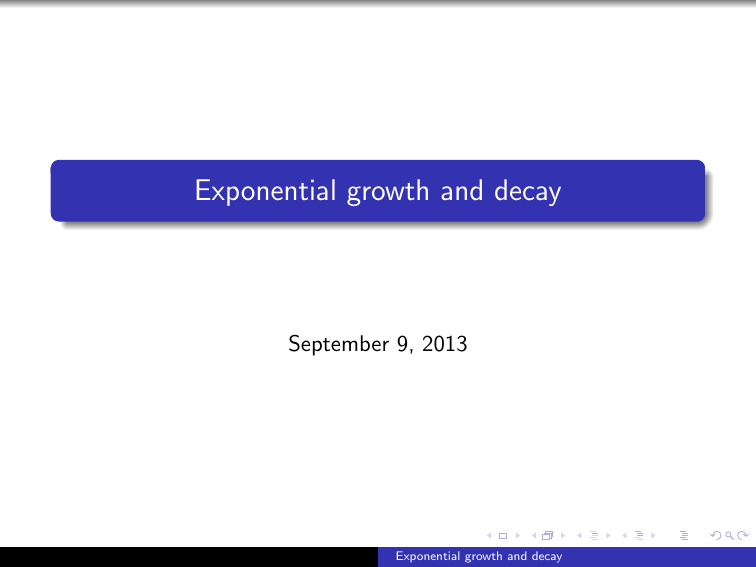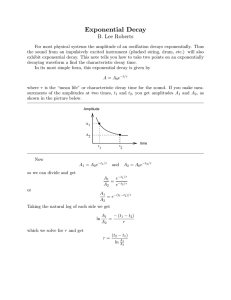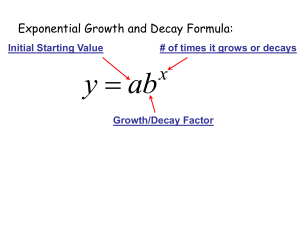Exponential growth and decay
advertisement

Exponential growth and decay September 9, 2013 Exponential growth and decay Examples Many quantities in nature change according to an exponential growth or decay function of the form P = P0 e kt , where P0 is the initial quantity and k is the continuous growth or decay. Exponential growth and decay Examples Problem 1. The Environmental Protection Agency recently investigated a spill of radioactive iodine. The radiation level at the site was about 2.4 milirems/hour (four times the maximum acceptable limit of 0.6 milirems/hour), so the EPA ordered an evacuation of the surrounding area. The level of radiation from the iodine source decays as a continuous hourly rate of k = −0.004. Exponential growth and decay Examples Problem 1. The Environmental Protection Agency recently investigated a spill of radioactive iodine. The radiation level at the site was about 2.4 milirems/hour (four times the maximum acceptable limit of 0.6 milirems/hour), so the EPA ordered an evacuation of the surrounding area. The level of radiation from the iodine source decays as a continuous hourly rate of k = −0.004. What was the level of radiation 12 hours later? Exponential growth and decay Examples Problem 1. The Environmental Protection Agency recently investigated a spill of radioactive iodine. The radiation level at the site was about 2.4 milirems/hour (four times the maximum acceptable limit of 0.6 milirems/hour), so the EPA ordered an evacuation of the surrounding area. The level of radiation from the iodine source decays as a continuous hourly rate of k = −0.004. What was the level of radiation 12 hours later? Find the number of hours until the level of radiation reached the maximum acceptable limit, and the inhabitants could return. Exponential growth and decay Examples Problem 1. The Environmental Protection Agency recently investigated a spill of radioactive iodine. The radiation level at the site was about 2.4 milirems/hour (four times the maximum acceptable limit of 0.6 milirems/hour), so the EPA ordered an evacuation of the surrounding area. The level of radiation from the iodine source decays as a continuous hourly rate of k = −0.004. What was the level of radiation 12 hours later? Find the number of hours until the level of radiation reached the maximum acceptable limit, and the inhabitants could return. Formula of the radiation level: R = 2.4e −0.004t . Exponential growth and decay Examples Problem 1. The Environmental Protection Agency recently investigated a spill of radioactive iodine. The radiation level at the site was about 2.4 milirems/hour (four times the maximum acceptable limit of 0.6 milirems/hour), so the EPA ordered an evacuation of the surrounding area. The level of radiation from the iodine source decays as a continuous hourly rate of k = −0.004. What was the level of radiation 12 hours later? Find the number of hours until the level of radiation reached the maximum acceptable limit, and the inhabitants could return. Formula of the radiation level: R = 2.4e −0.004t . After 12 hours: R = 2.4e (−0.004)(12) Exponential growth and decay Examples Problem 1. The Environmental Protection Agency recently investigated a spill of radioactive iodine. The radiation level at the site was about 2.4 milirems/hour (four times the maximum acceptable limit of 0.6 milirems/hour), so the EPA ordered an evacuation of the surrounding area. The level of radiation from the iodine source decays as a continuous hourly rate of k = −0.004. What was the level of radiation 12 hours later? Find the number of hours until the level of radiation reached the maximum acceptable limit, and the inhabitants could return. Formula of the radiation level: R = 2.4e −0.004t . After 12 hours: R = 2.4e (−0.004)(12) = 2.2875 Exponential growth and decay Examples Problem 1. The Environmental Protection Agency recently investigated a spill of radioactive iodine. The radiation level at the site was about 2.4 milirems/hour (four times the maximum acceptable limit of 0.6 milirems/hour), so the EPA ordered an evacuation of the surrounding area. The level of radiation from the iodine source decays as a continuous hourly rate of k = −0.004. What was the level of radiation 12 hours later? Find the number of hours until the level of radiation reached the maximum acceptable limit, and the inhabitants could return. Formula of the radiation level: R = 2.4e −0.004t . After 12 hours: R = 2.4e (−0.004)(12) = 2.2875 Find t so that: 0.6 = 2.4e −0.004t Exponential growth and decay Examples Problem 2. The population of Kenya was 19.5 million in 1984 and 39.0 million in 2009. Assuming that the population increases exponentially, find a formula for the population of Kenya as a function of time. Exponential growth and decay Examples Problem 2. The population of Kenya was 19.5 million in 1984 and 39.0 million in 2009. Assuming that the population increases exponentially, find a formula for the population of Kenya as a function of time. P = P0 e kt , where t is the number of years since 1984. Exponential growth and decay Examples Problem 2. The population of Kenya was 19.5 million in 1984 and 39.0 million in 2009. Assuming that the population increases exponentially, find a formula for the population of Kenya as a function of time. P = P0 e kt , where t is the number of years since 1984. We need to find P0 and k. Exponential growth and decay Examples Problem 2. The population of Kenya was 19.5 million in 1984 and 39.0 million in 2009. Assuming that the population increases exponentially, find a formula for the population of Kenya as a function of time. P = P0 e kt , where t is the number of years since 1984. We need to find P0 and k. P0 = 19.5 Exponential growth and decay Examples Problem 2. The population of Kenya was 19.5 million in 1984 and 39.0 million in 2009. Assuming that the population increases exponentially, find a formula for the population of Kenya as a function of time. P = P0 e kt , where t is the number of years since 1984. We need to find P0 and k. P0 = 19.5 39 = 19.5e k·25 Exponential growth and decay Doubling time and Half-life Definition The doubling time of an exponentially increasing quantity is the time required for the quantity to double. The half-life of an exponentially decaying quantity is the time required for the quantity reduced by a factor of one half. Exponential growth and decay Examples Harder problem: Show that every exponentially increasing function has a fixed doubling time. Exponential growth and decay Examples Problem 3. The release of chlorofluorocabons (CFC) used in air conditioners and household sprays destroys the ozone in the upper atmosphere. The quantity of ozone, Q, is decaying exponentially at a continuous rate of 0.25% per year. What is the half-life of ozone? Exponential growth and decay Examples Problem 3. The release of chlorofluorocabons (CFC) used in air conditioners and household sprays destroys the ozone in the upper atmosphere. The quantity of ozone, Q, is decaying exponentially at a continuous rate of 0.25% per year. What is the half-life of ozone? We need to find t (in years) so that: Q0 2 = Q0 e −0.0025t . Exponential growth and decay Examples Problem 3. The release of chlorofluorocabons (CFC) used in air conditioners and household sprays destroys the ozone in the upper atmosphere. The quantity of ozone, Q, is decaying exponentially at a continuous rate of 0.25% per year. What is the half-life of ozone? We need to find t (in years) so that: 1 2 Q0 2 = Q0 e −0.0025t . = e −0.00025t Exponential growth and decay Examples Problem 3. The release of chlorofluorocabons (CFC) used in air conditioners and household sprays destroys the ozone in the upper atmosphere. The quantity of ozone, Q, is decaying exponentially at a continuous rate of 0.25% per year. What is the half-life of ozone? We need to find t (in years) so that: Q0 2 = Q0 e −0.0025t . = e −0.00025t ln 12 = −0.0025t 1 2 Exponential growth and decay Examples Problem 3. The release of chlorofluorocabons (CFC) used in air conditioners and household sprays destroys the ozone in the upper atmosphere. The quantity of ozone, Q, is decaying exponentially at a continuous rate of 0.25% per year. What is the half-life of ozone? We need to find t (in years) so that: Q0 2 = Q0 e −0.0025t . = e −0.00025t ln 12 = −0.0025t 1 2 t= ln(1/2) −0.0025 Exponential growth and decay Examples Problem 3. The release of chlorofluorocabons (CFC) used in air conditioners and household sprays destroys the ozone in the upper atmosphere. The quantity of ozone, Q, is decaying exponentially at a continuous rate of 0.25% per year. What is the half-life of ozone? Q0 −0.0025t 2 = Q0 e 1 −0.00025t 2 =e ln 12 = −0.0025t Exponential growth and decay Examples Problem 3. The release of chlorofluorocabons (CFC) used in air conditioners and household sprays destroys the ozone in the upper atmosphere. The quantity of ozone, Q, is decaying exponentially at a continuous rate of 0.25% per year. What is the half-life of ozone? Q0 −0.0025t 2 = Q0 e 1 −0.00025t 2 =e ln 12 = −0.0025t ln(1/2) t = −0.0025 = 277 Exponential growth and decay Examples Problem 4. If $100,000 is deposited in an account paying interest at a rate of 5% per year, compounded continuously, the how long does it take for the balance in the account to reach $150,000? Exponential growth and decay Examples Problem 4. If $100,000 is deposited in an account paying interest at a rate of 5% per year, compounded continuously, the how long does it take for the balance in the account to reach $150,000? We need to find t so that: 150, 000 = 100, 00e 0.05t . Exponential growth and decay Rule of 70 Extra question: Calculate the doubling time, D, for interest rates of 1%, 3%, 5%, and 6% per year, compounded continuously. Exponential growth and decay Rule of 70 Extra question: Calculate the doubling time, D, for interest rates of 1%, 3%, 5%, and 6% per year, compounded continuously. Assume the doubling time corresponding to the interest rate i% per year is Di . Use the results in the previous part to compare Di and 70/i. Exponential growth and decay Rule of 70 To compute the approximate doubling time of an investment, divide 70 by the percent annual interest rate. Exponential growth and decay Present and future values Many business deals involve payments in the future. For example, when a car is bought on credit, payments are made over a period of time. Being paid $1000 in the future is worse than being paid $1000 today. Therefore, even without considering inflation, if we are to accept payment in the future, we would expect to be paid more to compensate for this loss of potential earnings. The question is “How much more?”. Definition The future value, B, of a payment P, is the amount to which the P would have grown if deposited today in an interest-bearing bank account. The present value, P, of a future payment B, is the amount that would have to be deposited in a bank account today to produce exactly B in the account at the relevant time in future. Exponential growth and decay Present and future values Suppose B is the future value of P, and P is the present value of B. If interest is compounded annually at a rate r for t years, then B = P(1 + r )t , or equivalently, P= Exponential growth and decay B . (1 + r )t Present and future values Suppose B is the future value of P, and P is the present value of B. If interest is compounded annually at a rate r for t years, then B = P(1 + r )t , or equivalently, P= B . (1 + r )t If interest is compounded continuously at a rate r for t years, then B = Pe rt , or equivalently, P= B = Be −rt . e rt Exponential growth and decay Example Problem 5. You win the lottery and are offered the choice between $1 million in four yearly installments of $250,000 each, starting now, and a lump-sum payment of $920,000 now. Assuming a 6% interest rate per year, compounded continuously, and ignoring taxes, which should you choose? Exponential growth and decay Example Problem 5. You win the lottery and are offered the choice between $1 million in four yearly installments of $250,000 each, starting now, and a lump-sum payment of $920,000 now. Assuming a 6% interest rate per year, compounded continuously, and ignoring taxes, which should you choose? (a) Compare present value of the first payment method. Exponential growth and decay Example Problem 5. You win the lottery and are offered the choice between $1 million in four yearly installments of $250,000 each, starting now, and a lump-sum payment of $920,000 now. Assuming a 6% interest rate per year, compounded continuously, and ignoring taxes, which should you choose? (a) Compare present value of the first payment method. (b) Compare future value of two payment methods. Exponential growth and decay Example Problem 5. You win the lottery and are offered the choice between $1 million in four yearly installments of $250,000 each, starting now, and a lump-sum payment of $920,000 now. Assuming a 6% interest rate per year, compounded continuously, and ignoring taxes, which should you choose? (a) Compare present value of the first payment method. (b) Compare future value of two payment methods. (c) Find the answer if the interest is compounded annually at a rate 5% . Exponential growth and decay Compare future values 250, 000 + 250, 000e (−0.06)(1) + 250, 000e (−0.06)(2) + 250, 000e (−0.06)(3) Exponential growth and decay Compare future values 250, 000 + 250, 000e −(0.06)(1) + 250, 000e −(0.06)(2) + 250, 000e −(0.06)(3) 250,000+235,441+221,730+208,818=915,989 Exponential growth and decay Compare present values 920, 000e (0.06)(3) = 1, 101, 440 Exponential growth and decay Compare present values 920, 000e (0.06)(3) = 1, 101, 440 250, 000e (0.06)(3) + 250, 000e (0.06)(2) + 250, 000e (0.06)(1) + 250, 000 Exponential growth and decay Compare present values 920, 000e (0.06)(3) = 1, 101, 440 250, 000e (0.06)(3) + 250, 000e (0.06)(2) + 250, 000e (0.06)(1) + 250, 000 299,304+281,874+265,459+250,000=1,096,637 Exponential growth and decay Compare present values 250, 000 + 250,000 (1.05) + 250,000 (1.05)2 + 250,000 (1.05)3 Exponential growth and decay Compounded annually 250, 000 + 250,000 (1.05) + 250,000 (1.05)2 + 250,000 (1.05)3 250, 000 + 238, 095 + 226, 757 + 215, 959 Exponential growth and decay




